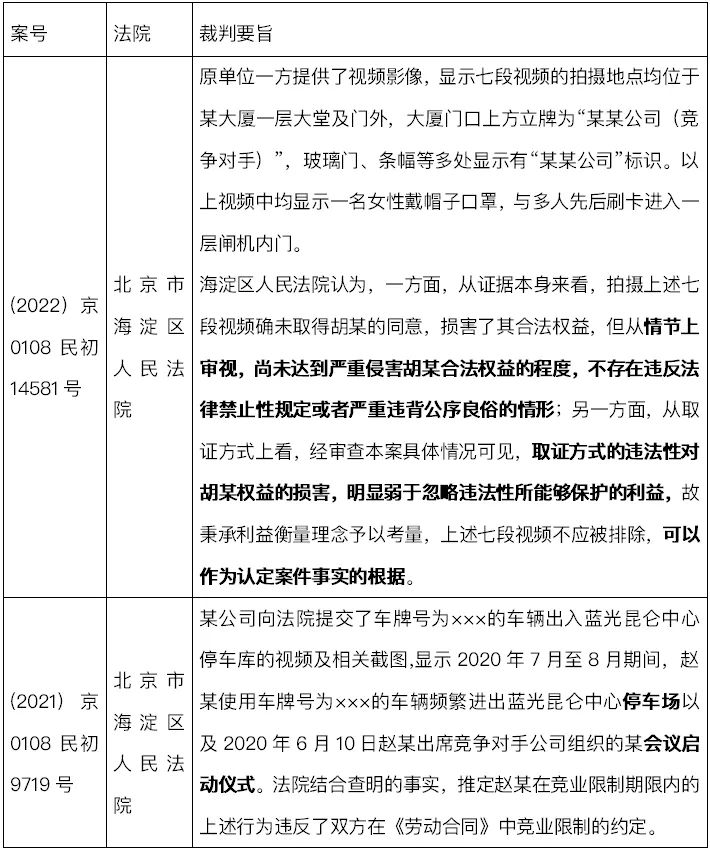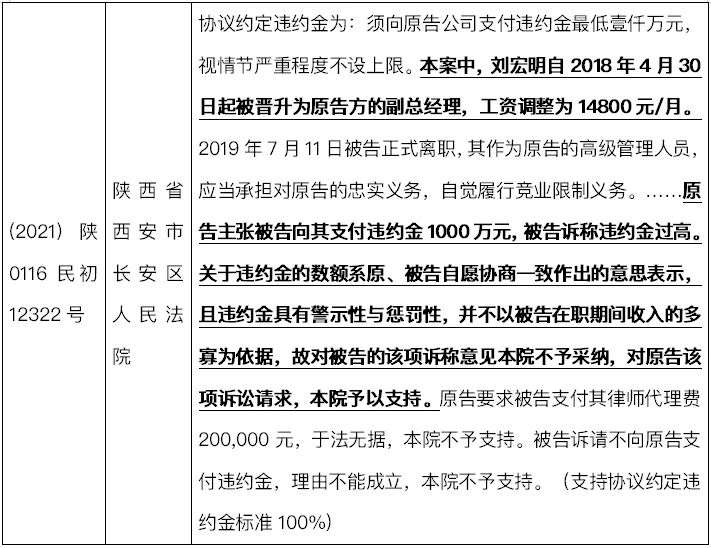Competition Restrictions: The Game between Corporate Defense Lines and Employee Boundaries (Part 2)
When companies and employees compete on the battlefield of non compete restrictions, the allocation of burden of proof, the reasonableness of liquidated damages, and the attribution of jurisdiction often become key factors determining the outcome. Are employees really 'crossing boundaries'? How can employers use the evidence chain to lock in the fact of breach of contract? Can stolen surveillance videos be accepted by the court? Is the sky high penalty for breach of contract a deterrent or a 'tyrannical clause'? How can the jurisdictional dispute be resolved when options disputes are navigating between labor law and commercial contracts? This article will follow up on "Competition Restrictions: The Game between Corporate Defense Lines and Employee Boundaries (Part 1)" (click to view) and further analyze the above issues.
1、 Has the employee violated their non compete obligation? ——How should employers provide evidence
How hard is the evidence to be presented? ——How much burden of proof does the unit need to bear?
In non compete dispute cases, the original employer can collect evidence of employee breach of contract through public channels such as business registration, official website information, patent applications, and social security records. However, in reality, employees often adopt covert methods to avoid evidence, such as indirectly providing services or holding investments on behalf of others, which makes direct evidence collection difficult.
In judicial practice, when an employer provides preliminary evidence (such as records of employees entering and leaving competing companies, workplace images, etc.) to prove the possibility of breach of contract, the burden of proof shifts. At this point, employees need to provide reasonable explanations or counter evidence for suspicious behavior. If they cannot provide reasonable explanations or insufficient evidence, they may bear adverse consequences.
How to provide strong evidence? ——Several ways for employers to prove employee breach of contract
In non compete dispute cases, employers can adopt a multidimensional evidentiary strategy to prove employee breach of contract. For direct entry into competing companies, in addition to regular business registration and intellectual property information, official documents such as employment records, social security and housing fund, and personal income tax payment records can be obtained through legal application. But for some hidden breach behaviors, the way of collecting evidence needs to be more flexible:
1. Evidence of spatiotemporal behavior: Take video footage of employees frequently entering and exiting competitive company premises during normal working hours;
2. Identity related evidence: If an employee has received express delivery from a competing company, displayed their business card at company events, attended meetings, or signed contracts, these can all serve as evidence of their connection with the competing company;
3. Indirect participation evidence: If an employee holds shares through relatives and participates in the operation of a competing company, it is indirect evidence, which can further prove that the employee is engaged in "behind the scenes transactions".
4. Utilize big data on the internet to gather evidence, such as collecting news about employee job hopping or using AI tools (such as Doubao or DeepSeek) to directly inquire whether employees have gone to competing companies, in order to draw big data conclusions as supporting evidence.
Can stealing recordings be used as evidence? ——The legal boundary of employees' job hopping secretly filmed by the unit
In non compete disputes, many employers may choose to film employees' audio and video in public places as evidence. So, can this type of evidence be accepted by the court? The key to the answer lies in whether it meets the requirements of Article 106 of the Interpretation of the Civil Procedure Law regarding the legality of evidence. The court will examine the validity of such evidence from four dimensions: the openness of the venue, the legitimacy of the purpose, the completeness of the evidence, and the reasonable interpretation of the parties involved.
1. Openness of the venue: If the shooting takes place in public areas such as company gates or public parking lots, it is usually not considered a violation of privacy as it does not involve private space;
2. Legitimacy of purpose: The purpose of filming is to prove whether the employee has violated non compete restrictions, rather than simply infringing on personal rights. Therefore, such evidence collection behavior is fundamentally different from covert filming behavior;
3. Integrity of evidence: Individual visual evidence has limited probative value and needs to be combined with other evidence (such as entry and exit records, work permits, etc.) to form a complete chain of evidence. Only multi angle evidence can ensure effectiveness;
4. Reasonable explanation: The court is more concerned with whether the employee can provide a reasonable explanation for the behavior captured on camera, rather than being overly fixated on evidence collection methods.

2、 Is the penalty for breach of contract too high to offer discounts—— How can high liquidated damages be justified
In practice, we often encounter situations where employers claim high liquidated damages. How does the court determine whether the money received is "excessive"? The author believes that the "value of this price" can be demonstrated from the following aspects:
1. How many secrets do employees truly possess? For example, employees who have worked in the company for many years, directly manage multiple core departments, hold a large number of documents related to team management and business strategy, and have also participated in the release of some key confidential information, proving that employees possess a large number of business secrets of the company and require high liquidated damages to prevent them from violating their non compete obligations;
2. If an employee receives high salary benefits during their time in the company and the company provides them with high non compete compensation after leaving, then the employee who receives high benefits should be equally compensated with high liquidated damages;
3. The violation of non compete restrictions by employees is extremely malicious. If an employee knowingly goes to a competing unit and maliciously poaches people from the original unit, using the resources obtained in the original unit for the development of the competing unit, it is a serious malicious breach of contract.
Whether a high penalty for breach of contract can be justified should be examined from multiple perspectives. The law should not only protect the interests of employees, but also safeguard the core trade secrets of enterprises and maintain healthy competition in the entire industry.

3、 Who is in charge of option disputes? ——The jurisdictional issue starting from "labor" or "contract"
In judicial practice, high non compete restrictions may also be accompanied by equity incentives. There are different opinions on whether disputes involving equity incentives belong to labor disputes. One viewpoint is that such disputes should be included in the scope of labor dispute acceptance. The reason is that the equity incentive system is usually based on the premise of a labor relationship between the employer and the incentive object, and its incentive consideration is that the incentive object provides labor services to the employer, thus having a significant labor compensation attribute. In this case, equity incentive disputes arise from labor relations and belong to labor disputes. They should be resolved through labor dispute arbitration procedures first before entering litigation proceedings. For example, the Beijing First Intermediate People's Court pointed out in relevant research that if there is a labor relationship between the incentive object and the incentive subject, disputes arising from the payment of equity incentive targets should be regarded as disputes based on labor remuneration, and the provisions of the Labor Dispute Mediation and Arbitration Law and relevant judicial interpretations should be applied. Such disputes may involve the effectiveness of equity incentive agreements, exercise conditions, payment methods, and compensation for losses; When the equity incentive subject matter is partially or fully paid, any issues related to shareholder qualifications, shareholder rights, etc. arising from it belong to shareholder rights disputes in the sense of company law and no longer fall within the scope of labor disputes.
Correspondingly, another viewpoint holds that equity incentive disputes should be defined as contract disputes, directly under the jurisdiction of the court, without the need for pre litigation procedures such as labor arbitration. This viewpoint emphasizes that equity incentive behavior is essentially a way for enterprises to grant certain shareholder rights to incentive recipients with specific conditions, enabling them to participate in corporate governance and profit sharing as shareholders. This type of arrangement is mainly aimed at middle and senior management personnel and core technical backbone of enterprises, with strong bargaining power and civil equality in agreement signing. From the perspective of the nature of rights, its incentive benefits come from the property rights attached to shareholder status, which are fundamentally different from wage compensation based on labor relations, and have obvious characteristics of capital gains. The relevant option agreement parties (mostly overseas entities) are likely not the employers of labor contracts (mostly domestic entities). Therefore, such legal relationships should be regarded as civil and commercial contract relationships established based on contracts between equal civil subjects, and adjusted in accordance with the relevant provisions of the Contract Section of the Civil Code, rather than being included in the scope of labor disputes.

In summary, the determination of the cause of action in equity incentive disputes directly affects the accepting institution and jurisdictional court of the case. There is no unified theory on this in judicial practice. It is necessary to comprehensively judge the attributes of incentive agreements and the legal relationship between incentive objects and enterprises based on the specific circumstances of the case, in order to determine the applicable legal norms and procedural paths.
4、 Conclusion
Non compete agreements play a crucial role in balancing the commercial interests of employers and the employment rights of workers, and the level of refinement in their legal application is constantly increasing. Faced with the definition of applicable objects, the delineation of non compete scope, the assumption of breach of contract liability, and the reasonable review of liquidated damages, judicial practice has gradually formed predictable judgment rules, and also put forward higher requirements for agreement design.
At the level of compliance operations, employers should pay attention to the scientific design of front-end systems and the standardized fulfillment of compensation obligations, in order to avoid the risk of "high constraints and low compensation" leading to invalid agreements or reduced liquidated damages; Workers should rationally evaluate the scope and consequences of their non compete obligations, and exercise their rights of defense and remedy reasonably. Only in this way can the non compete system truly play its institutional function of protecting legitimate interests and preventing unfair competition.




